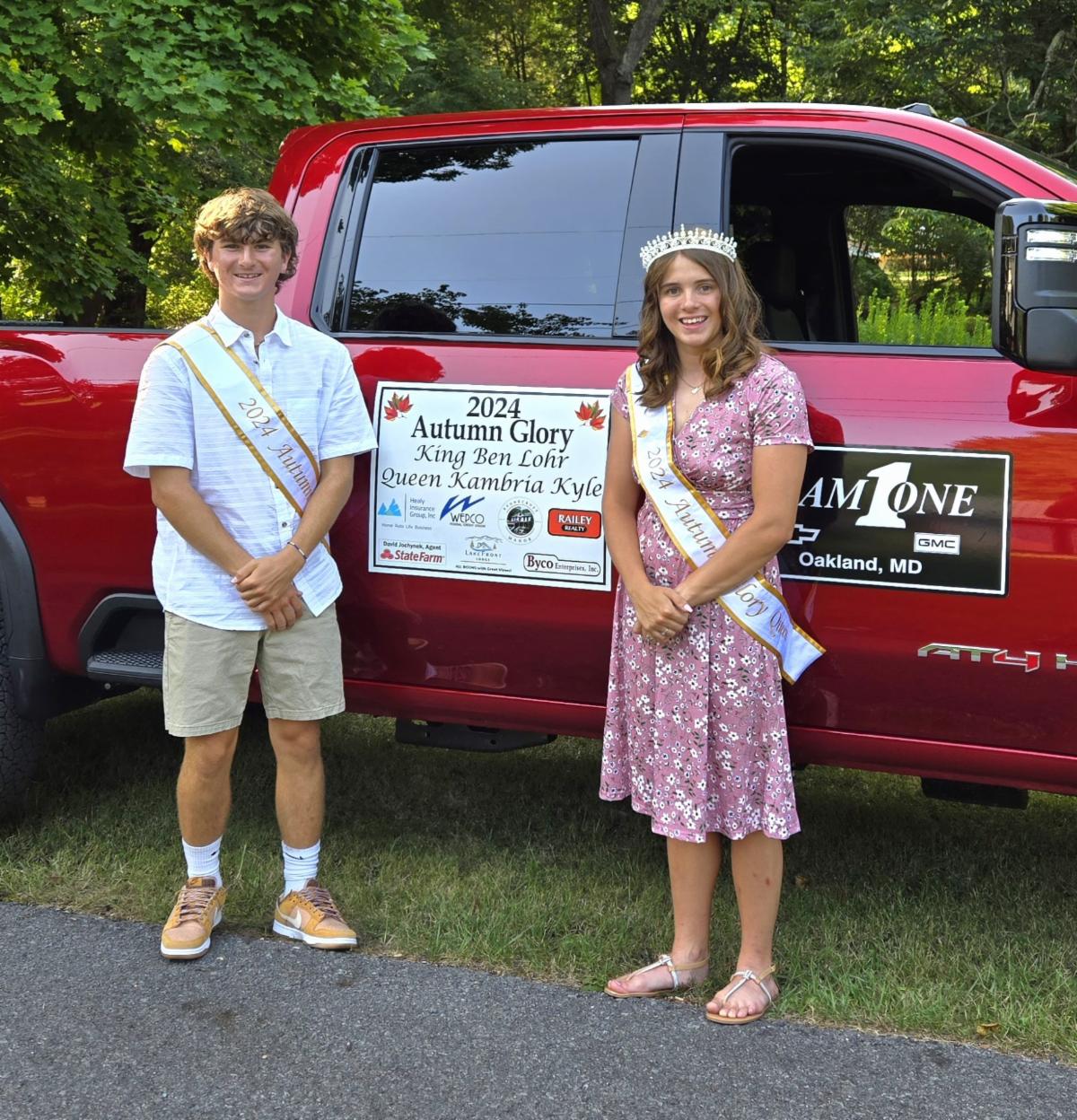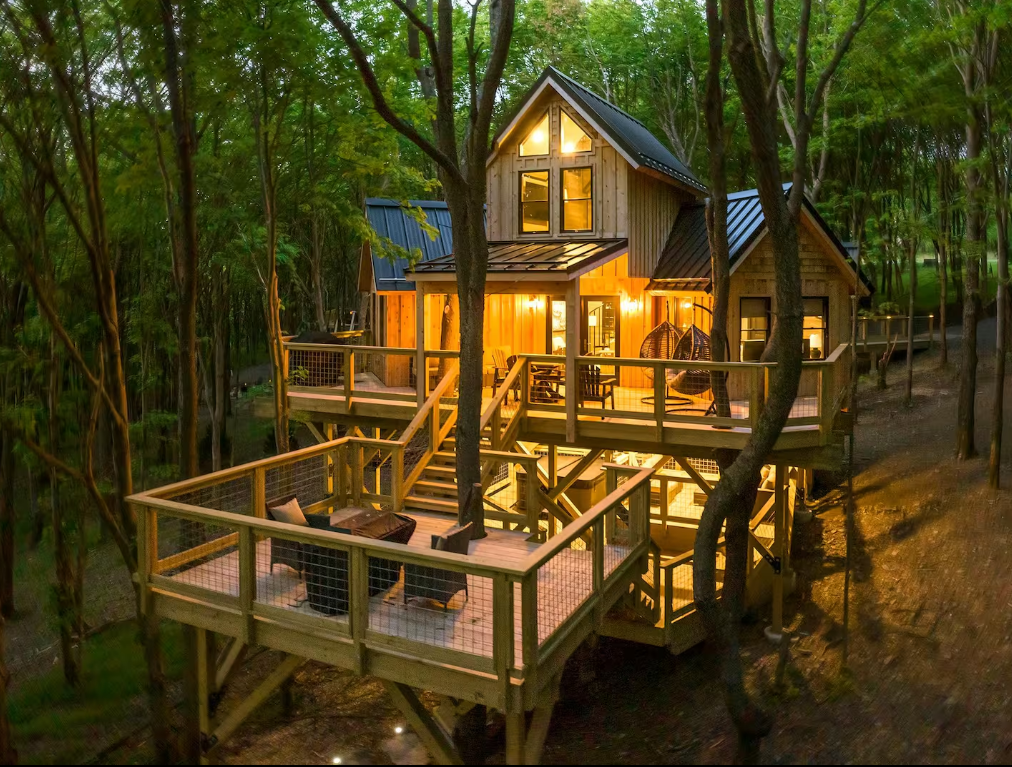Appalachian Forest
When Western Maryland was a mysterious and distant territory to most Americans, for German immigrants, it felt just like home. Among the villages they settled in, one in present-day Garrett County came to be known nostalgically as New Germany. Today, this village is the location of New Germany State Park. Over a century after its settlement, New Germany hosted the first ski resort south of the Mason-Dixon Line and earned the region the moniker of “Maryland’s Alps.” In between the first German settlers and the ski resort, the land was transformed and made anew. To return to its alpine reputation, New Germany has witnessed the rise and fall of timbering, the growth of scientific forestry, and the snowballing success of outdoor recreation.
When German settlers first arrived in present-day Garrett County, the dense forest seemed like fertile ground for a new start. They were leaving behind war, strife, and their peasant pasts in the old country, where they were subject to feudal obligations. In the eighteenth century, the westward advance of White settlers and the wars they fought against Native American tribes had pushed out much of Western Maryland’s Indigenous occupants. While the German settlers who arrived in New Germany in the 1790s were seeking the opportunity to freely hold land and a reprieve from violence, the Native Americans had faced devastating conflict and dispossession.
The New Germans cleared the land and dammed Poplar Lick Run. By the 1850s, families like the Swaugers, Swartzendrubers, Ottos, and Bittingers had settled around the lake and established a multistory saw and grist mill below the dam. Run by John Swauger, the sawmill harvested the expanses of white pine in New Germany. While most of the New Germans were farmers, by the late nineteenth century they cashed in on the burgeoning timber trade.
View fullsize
The New Germany area as surveyed by the US Geological Survey in 1898, Swauger’s Mill in red, potential locations for the McAndrews Mill in green, Durst and Funk in purple, and Otto’s in teal.
The trees of Western Maryland couldn’t fall fast enough. When transportation lines like the National Road and the Baltimore & Ohio Railroad opened Western Maryland to larger markets, logging companies poured in to harvest the dense forests. Wood supplied housing material, paper, was the dominant source of fuel and heat, and made up the ties of railroads that criss-crossed the nation. Garrett County, once almost entirely forest, saw its trees felled to a point that by 1900, of the forested land not already cleared for farming, eighty-nine percent had been cutover from timbering.
While much of the timberland was in large holdings owned by coal and lumber companies, the New Germans carved out enough of their own plot to form the timbering group McAndrews & Simpson, Christian Otto, Bittinger & Wiley. The men were immigrants or the sons of immigrants and had set up several operations along their local creeks. The introduction of circular steam-powered sawmills, like those produced by H&F Blandy, offered the farmers industrial-style productivity. Swauger’s Mill, running antiquated up-and-down saws, was retired to be solely a gristmill that was later run by Philip McAndrew. McAndrew, the lone Irishman of the group, operated his own sawmill along Elk Lick Run. Christian Otto’s industrial sawmill lay on the edge of his farm on Meadow Mountain. On Poplar Lick Run, a half mile North of the old Swauger Mill were the Funk and Durst Mills, both operating Blandy equipment, and 300 feet apart from each other. These German families may have been cut into the McAndrews, Simpson, Otto, Bittinger, and Wiley operations, or were staking out their own claims in the booming industry.
View fullsize
Ad for a Blandy steam-powered saw mill (Library of Congress)
View fullsize
New Germany is in the quadrant third from the right, and second down, the forested land around the creeks are culled while the ridge timber along Meadow Mountain remains
By 1902 most of the forested land surrounding New Germany had been culled and cutover, and what remained along Meadow Mountain to the east was the most undesirable Ridge Timber (in comparison to the more commerciable Slope and Swamp Timber), a forest type characterized by shallow soil, short trunks, and habitation of fungi and insects. It was during this time, when mountaintops appeared bare and the endless harvest looked near its end, when voices for conservation began gaining ground. At the highest level, Gifford Pinchot of the newly formed US Division of Forestry, was calling for a scientific management of forest resources. His protege, Fred Besley, became Maryland’s first state forester in 1906. Max Rothkugel, another of Pinchot’s colleagues, established one of the first experimental tree plantations of its kind in West Virginia.
View fullsize
Besley’s map of the forests of Garrett County in 1915, the sections marked “c” indicate culled hardwood trees
For foresters like Besley, the treatment of the forest was careless and wasteful. Companies overestimating demand and tanneries who stripped hemlock for its bark left behind large quantities of wood to rot on the forest floor. In New Germany, misplaced white pine logs and stumps laid sunken to the bottom of New Germany Lake. Farmers, especially in Garrett County, cleared land for grazing by burning it. Throughout Maryland forest fires raged, especially in vulnerable cutover lands. Besley advocated for forestry by speaking the language of business, claiming “the present lack of good forest management means a real loss to [Garrett] County of an annual revenue amounting to at least $650,000.” His mission above all was to assign Maryland’s land to “the most profitable uses.”
At first, Besley focused on curbing forest fires and educating landowners on ways to manage and market their timber resources. Less than 3,000 acres of forestland were in state hands in the early 1900s. Yet, Besley’s arguments for conservation failed to sway landowners, and the American economy of unyielding consumption barreled on to the year 1929. The economic collapse and Great Depression that followed gave the government a new mandate for action. The 1929 Federal Utilization Land Program enabled the state to purchase farmland labeled “submarginal” and reconvert it into forest. As a part of the New Deal, the Civilian Conservation Corps (CCC) were put to work, replanting trees, developing recreational facilities, and forming a vanguard of scientific management.
the McAndrews House and (Old Swauger) mill (courtesy Maryland DNR)
View fullsize
The village of New Germany in 1929
The CCC camp below Meadow Mountain (courtesy Maryland DNR)
The act of seizing “submarginal” land was less clean in practice. Not everyone would take a check for the land they had lived and relied on. The farms of more obstinate families would be condemned and they would be evicted. Through this process Maryland acquired 50,000 acres in 1929, including much of the land in and around New Germany. Some parts of the New Germany community survived, including the Otto family, who ran a grocery store, filling station, and farm, and the McAndrews, who came to own much of the land around the lake. New Germany’s one-room schoolhouse remained in use until the 1950s, and still stands today. Otherwise many New Germany farmers were bought out and the land passed into new hands once again to form New Germany Forest Recreation Area (later designated as a state park) and the surrounding Savage River State Forest.
Norway Spruces in rows along New Germany’s Orchard Loop trail
The CCC set up Camp S-52 of Company 326 in New Germany. The young men who joined spent their first winter in tent camps as they built up the infrastructure of the park. They rebuilt the dam and constructed barracks, recreation and mess halls, and cabins out of American chestnut. An early favorite for planting was the Norway Spruce, native to Northern Europe. The CCC also planted Scotch pine and red pine, species native to the Northeastern US, but not Maryland. These species were selected for their ability to repair a damaged landscape, sturdy enough to survive in depleted soil and speedy enough to establish roots that prevented further erosion. Their method for planting was mechanical, girdling old trees to allow younger saplings to take over and arranging the saplings in perfect rows. The New Germany’s CCC camp stood from 1933 until 1938, when some operations moved to Meadow Mountain. CCC work continued in New Germany until 1942.
The ski resort at New Germany emerged from the conservation of the land and the rise of outdoor recreation. In the late nineteenth century, Western Maryland had seen the development of resorts like Deer Park Hotel in Garrett County as getaway locations for wealthy city folk. The sentiment came from a Progressive Era belief in the outdoors as an important site for improved health and leisure. For urban reformers pushing for more park space, the development of recreation spaces was crucial for people of all classes. Fred Besley tapped into these rising currents and developed state forests as state parks in order to secure more funding for forestry.
With its vacation resorts and a new system of parks set up by the CCC, Garrett County earned its reputation as a summer getaway. Yet in the late 30s, ski clubs from Cumberland, Baltimore, and Washington, DC were begging for a resort in the mountains of Western Maryland. Skiing was taking off in the 1930s: the invention of rope-tows in 1932 meant skiers wouldn’t have to climb up mountains to ski down them and the 1936 Winter Olympics had debuted an alpine skiing event. Maryland state foresters Henry Buckingham, Matthew Martin, and Joe Davis set out to make New Germany that resort. CCC members, National Youth Administration crews (another New Deal work program), and Washington Ski Club volunteers constructed the trails. As Maryland’s first ski resort, New Germany opened in 1940. By the mid-50s, the region’s first commercial ski resort had opened in nearby Canaan Valley, West Virginia.
View fullsize
Before New Germany Road (in red), some ski slopes cut down Meadow Mountain towards Poplar Lick Run and the lake
View fullsize
Tow rope on the Otto Farm (courtesy Maryland DNR)
Samuel Otto, son of Christian Otto, lent a portion of his property on Meadow Mountain for a downhill slalom course and beginner trails, while other slopes were built on McAndrew’s Hill, across the lake from Meadow Mountain. On the Otto Farm, the State set up a rope tow powered by a pickup truck while a car shuttle serviced another trail. New Germany exploded in popularity as its cabins were regularly booked through the winter. This never dissuaded avid skiers who would pile on the floor of the Martin House (now Cabin #11) in sleeping bags. City skiers from Baltimore and Washington, DC frequented the New Germany slopes. Young locals made do without the fancy skiers of the more affluent. A descendant of the Swaugers, who worked as a CCC carpenter and barber, created skis out of the hickory bows that came off of CCC trucks.
Skiing at New Germany, February 1941 (courtesy Maryland DNR)
Dorothy Moore, overnight sleeping bag, Feb 22, 1941
New Germany even hosted international meets. Scandinavian and German professionals came to these Maryland Alps. Skiing was a highly celebrated sport in Germany. Perhaps for these skiers the landscape seemed as familiar as it had been to the New Germans and maybe even more so with the CCC-planted Norway spruces native to their homelands. By one way or another, German culture seems to have persevered in New Germany.
The forests of New Germany have seen many changes. From their initial proliferation, to their widespread cutting and clearing, and then their resurgence. The scientific management employed by the CCC focused on the regrowth of timber and planted non-native trees for their speed and stability. The Maryland Parks Service has focused on maintaining the ecology of Western Maryland. They currently foster native species and promote biodiversity by replanting red spruces and eastern hemlocks. While the woods have reclaimed New Germany’s downhill slopes and the ski resort no longer exists, you can still tour the park on skis, via their expanded cross-country trails. Once an Alps-like getaway for city folk, New Germany has earned a new reputation as a local gem and “Maryland’s Best Kept Secret.”
Cross-country skiers atop a frozen New Germany Lake
References
Bailey, Robert. Maryland’s Forests and Parks: A Century of Progress. Charleston, SC: Arcadia Publishing, 2006.
Besley, F.W. The Forests of Maryland. Annapolis, MD: Press of the Advertiser-Republican, 1916.
Blank, Gary. “Forest Management History in the Central Appalachians 1900 to 2000.” Maryland Department of Natural Resources.
Cathell, David. “Garrett County Logging and Mining Railroads.” https://davecathell.tripod.com/garloco.html#clark.
“The Civilian Conservation Corps Part II: A Maryland Perspective.” Maryland Department of Natural Resources, https://dnr.maryland.gov/centennial/Pages/Centennial-Notes/CCC_History_Part_II.aspx.
Curran, H.M. “The Forests of Garrett County,” in Maryland Geological Survey: Garrett County. W. Bullock Clark, Baltimore, MD: Johns Hopkins Press, 1902, 303-329
Durst, Ross. “The Mills of New Germany.” The Glades Star 2, no. 18(1955)
Foxfire 10. eds. George Reynolds et al., New York, NY: Anchor Books, 1993
Hennighausen, L.P. “Early German Settlements in Western Maryland,” in Sixth Annual Report of the Society for the History of the Germans, Baltimore, MD: Schneidereith & Sons, 1892, 13-25
Lund, Morten. “The 1930s: The Unexpected Blossoming of Alpine Skiing.” International Skiing History Association, https://www.skiinghistory.org/gallery/1930s-unexpected-blossoming-alpine-skiing.
Maryland State Archives, “Garrett County Mill Chapter,” https://msa.maryland.gov/megafile/msa/speccol/sc4300/sc4300/000005/000000/000007/unrestricted/garrett%20county%20mill%20chapter.pdf
Nead, Daniel. The Pennsylvania-German in the Settlement of Maryland. Lancaster, PA: The New Era Printing Company, 1913.
“New Germany State Park.” Maryland Department of Natural Resources, https://dnr.maryland.gov/publiclands/Pages/western/NewGermany/Heritage.aspx.
Northeastern Lumber Manufacturers Association, “The Norway Spruce Story.” https://www.nelma.org/the-norway-spruce-story/.
Zumbrun, Francis. “Skiing comes to the ‘Maryland Alps’ in 1940.” Maryland Department of Natural Resources, https://dnr.maryland.gov/centennial/Pages/Centennial-Notes/Skiing-NewGermany.aspx.






 March 31 – April 6, 2025
March 31 – April 6, 2025

 April Lunch N Learn: Bereavement at Work – April 3Downstairs @ UNO Pizzeria & Grill – 12:00 pm – 1:30 pm.Enjoy a light lunch and hear from Dr. Kent Tonkin, Associate Professor at Saint Francis University, Loretto, PA, on the topic of bereavement in the workplace. Lunch will be provided at no cost to attendees thanks to the generous sponsorship of C&S Fredlock Funeral Home, P.A.
April Lunch N Learn: Bereavement at Work – April 3Downstairs @ UNO Pizzeria & Grill – 12:00 pm – 1:30 pm.Enjoy a light lunch and hear from Dr. Kent Tonkin, Associate Professor at Saint Francis University, Loretto, PA, on the topic of bereavement in the workplace. Lunch will be provided at no cost to attendees thanks to the generous sponsorship of C&S Fredlock Funeral Home, P.A.  April Business After Hours 2025 – Pawn Run Bar & KitchenThe Chamber is pleased to announce that Pawn Run Bar & Kitchen will be hosting our April Business After Hours on Thursday, April 10th from 5:00 pm – 7:00 pm.
April Business After Hours 2025 – Pawn Run Bar & KitchenThe Chamber is pleased to announce that Pawn Run Bar & Kitchen will be hosting our April Business After Hours on Thursday, April 10th from 5:00 pm – 7:00 pm.  Vote in the 2025 Board of Directors Election!Please be advised that official ballots for the 2025 Garrett County Chamber of Commerce Board of Directors election are in the mail and will be delivered to all primary representatives of in-county Chamber members. The Chamber is governed by a 15-member volunteer Board of Directors and 1/3 of Board is up for re-election each year. Primary representatives of in-county members will receive a Board ballot, bio, and a return envelope. Please review the candidates, select five, and have your ballot delivered to Garrett County Chamber of Commerce, 15 Visitors Center Drive, McHenry, MD 21541 no later than April 9, 2025. New Board members and officers will be announced at the Annual Membership Meeting & Dinner on Wednesday, June 4, 2025.
Vote in the 2025 Board of Directors Election!Please be advised that official ballots for the 2025 Garrett County Chamber of Commerce Board of Directors election are in the mail and will be delivered to all primary representatives of in-county Chamber members. The Chamber is governed by a 15-member volunteer Board of Directors and 1/3 of Board is up for re-election each year. Primary representatives of in-county members will receive a Board ballot, bio, and a return envelope. Please review the candidates, select five, and have your ballot delivered to Garrett County Chamber of Commerce, 15 Visitors Center Drive, McHenry, MD 21541 no later than April 9, 2025. New Board members and officers will be announced at the Annual Membership Meeting & Dinner on Wednesday, June 4, 2025. Cross Ireland Off Your Bucket List With Our 2026 “Shades of Ireland” Chamber TripThe Garrett County Chamber of Commerce is excited to announce an exciting new bucket list trip! We are partnering with the award-winning travel agency, Collette, to offer “Shades of Ireland” March 22-31, 2026. We will be holding a special Trip Preview Presentation on Tuesday, May 13, 2025, to give prospective travelers a taste of what’s in store during this life-changing tour and answer any questions you may have regarding the process, itinerary, and the lauded Collette Difference. Click here to download the “Shades of Ireland” flyer. Click here to register for the Preview Presentation.
Cross Ireland Off Your Bucket List With Our 2026 “Shades of Ireland” Chamber TripThe Garrett County Chamber of Commerce is excited to announce an exciting new bucket list trip! We are partnering with the award-winning travel agency, Collette, to offer “Shades of Ireland” March 22-31, 2026. We will be holding a special Trip Preview Presentation on Tuesday, May 13, 2025, to give prospective travelers a taste of what’s in store during this life-changing tour and answer any questions you may have regarding the process, itinerary, and the lauded Collette Difference. Click here to download the “Shades of Ireland” flyer. Click here to register for the Preview Presentation.  Now Accepting Applications for 2025 Autumn Glory RoyaltyPlease help spread the word that the Garrett County Chamber of Commerce is inviting all those Garrett County students currently in their junior year of high school to submit an Autumn Glory Royalty application for consideration. We will be choosing a King and a Queen to represent the 58th Annual Autumn Glory Festival at a variety of events throughout the summer and fall of 2025. Both the King and Queen will receive an educational contribution. As part of the application, you are required to submit a 300-word essay on why you think you should be selected to be part of the Royalty Court. In an effort to give all qualifying students a chance to become Autumn Glory Royalty we have eliminated the application fee. Interviews will be conducted by appointment in May and we hope to complete the process by June 1. Please click here to download the application. If you have any questions, please contact Nick Sharps at nick@garrettchamber.com or call (301) 387-8745.
Now Accepting Applications for 2025 Autumn Glory RoyaltyPlease help spread the word that the Garrett County Chamber of Commerce is inviting all those Garrett County students currently in their junior year of high school to submit an Autumn Glory Royalty application for consideration. We will be choosing a King and a Queen to represent the 58th Annual Autumn Glory Festival at a variety of events throughout the summer and fall of 2025. Both the King and Queen will receive an educational contribution. As part of the application, you are required to submit a 300-word essay on why you think you should be selected to be part of the Royalty Court. In an effort to give all qualifying students a chance to become Autumn Glory Royalty we have eliminated the application fee. Interviews will be conducted by appointment in May and we hope to complete the process by June 1. Please click here to download the application. If you have any questions, please contact Nick Sharps at nick@garrettchamber.com or call (301) 387-8745. Help Address Your Workforce Issues with the Updated Work Ethic Diploma Program!After 5 successful years we feel it is time to make some changes to the Work Ethic Diploma (WED) Program to keep the it relevant and take it to the next level. The concept of the program was originally put forward to the Garrett County Chamber of Commerce by employers who felt students were not learning the soft skills necessary to become productive members of the workforce.
Help Address Your Workforce Issues with the Updated Work Ethic Diploma Program!After 5 successful years we feel it is time to make some changes to the Work Ethic Diploma (WED) Program to keep the it relevant and take it to the next level. The concept of the program was originally put forward to the Garrett County Chamber of Commerce by employers who felt students were not learning the soft skills necessary to become productive members of the workforce. Office Depot – April Monthly SpecialsThis April, enjoy members-only exclusive specials with discounts of up to 84% off folders, desk accessories, sticky notes, and more. Take advantage of these monthly specials when you shop online for office, school, and home essentials at ODP Business Solutions. Click here to view the April 2025 Monthly Specials. Click here for more information on the program and to register.
Office Depot – April Monthly SpecialsThis April, enjoy members-only exclusive specials with discounts of up to 84% off folders, desk accessories, sticky notes, and more. Take advantage of these monthly specials when you shop online for office, school, and home essentials at ODP Business Solutions. Click here to view the April 2025 Monthly Specials. Click here for more information on the program and to register.



